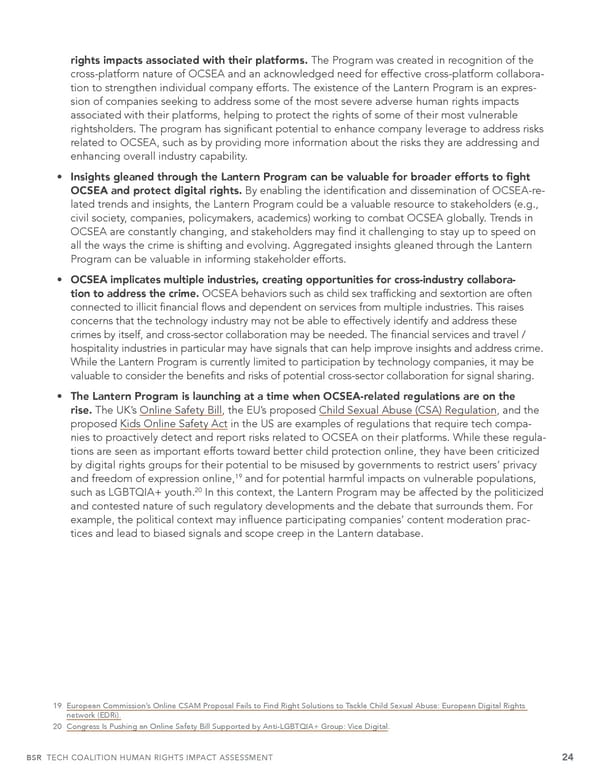rights impacts associated with their platforms. The Program was created in recognition of the cross-platform nature of OCSEA and an acknowledged need for effective cross-platform collabora- tion to strengthen individual company efforts. The existence of the Lantern Program is an expres- sion of companies seeking to address some of the most severe adverse human rights impacts associated with their platforms, helping to protect the rights of some of their most vulnerable rightsholders. The program has signi昀椀cant potential to enhance company leverage to address risks related to OCSEA, such as by providing more information about the risks they are addressing and enhancing overall industry capability. • Insights gleaned through the Lantern Program can be valuable for broader efforts to 昀椀ght OCSEA and protect digital rights. By enabling the identi昀椀cation and dissemination of OCSEA-re- lated trends and insights, the Lantern Program could be a valuable resource to stakeholders (e.g., civil society, companies, policymakers, academics) working to combat OCSEA globally. Trends in OCSEA are constantly changing, and stakeholders may 昀椀nd it challenging to stay up to speed on all the ways the crime is shifting and evolving. Aggregated insights gleaned through the Lantern Program can be valuable in informing stakeholder efforts. • OCSEA implicates multiple industries, creating opportunities for cross-industry collabora- tion to address the crime. OCSEA behaviors such as child sex traf昀椀cking and sextortion are often connected to illicit 昀椀nancial 昀氀ows and dependent on services from multiple industries. This raises concerns that the technology industry may not be able to effectively identify and address these crimes by itself, and cross-sector collaboration may be needed. The 昀椀nancial services and travel / hospitality industries in particular may have signals that can help improve insights and address crime. While the Lantern Program is currently limited to participation by technology companies, it may be valuable to consider the bene昀椀ts and risks of potential cross-sector collaboration for signal sharing. • The Lantern Program is launching at a time when OCSEA-related regulations are on the rise. The UK’s Online Safety Bill, the EU’s proposed Child Sexual Abuse (CSA) Regulation, and the proposed Kids Online Safety Act in the US are examples of regulations that require tech compa- nies to proactively detect and report risks related to OCSEA on their platforms. While these regula- tions are seen as important efforts toward better child protection online, they have been criticized by digital rights groups for their potential to be misused by governments to restrict users’ privacy 19 and freedom of expression online, and for potential harmful impacts on vulnerable populations, 20 such as LGBTQIA+ youth. In this context, the Lantern Program may be affected by the politicized and contested nature of such regulatory developments and the debate that surrounds them. For example, the political context may in昀氀uence participating companies’ content moderation prac- tices and lead to biased signals and scope creep in the Lantern database. 19 European Commission’s Online CSAM Proposal Fails to Find Right Solutions to Tackle Child Sexual Abuse: European Digital Rights network (EDRi). 20 Congress Is Pushing an Online Safety Bill Supported by Anti-LGBTQIA+ Group: Vice Digital. BSR TECH COALITION HUMAN RIGHTS IMPACT ASSESSMENT 24
 Tech Coalition Human Rights Impact Assessment of the Lantern Program Page 23 Page 25
Tech Coalition Human Rights Impact Assessment of the Lantern Program Page 23 Page 25